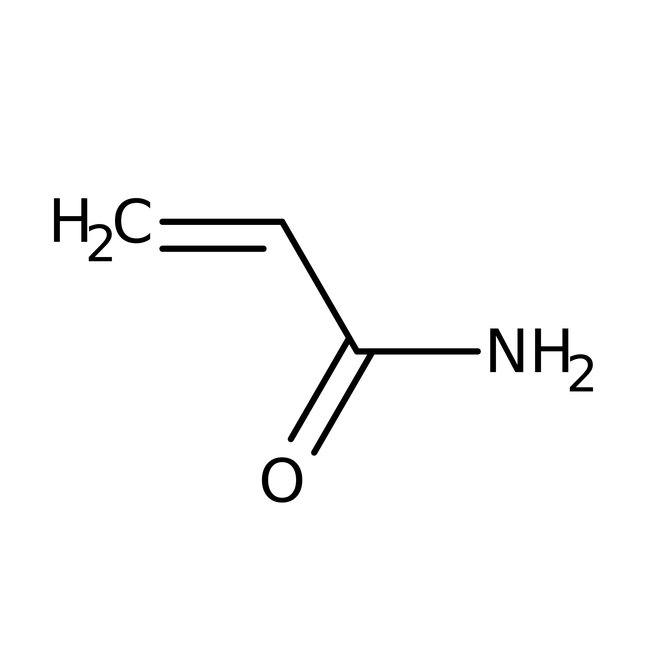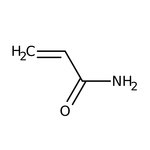Search Thermo Fisher Scientific
Thermo Scientific Chemicals
Acrylamide, 98+%
CAS: 79-06-1 | C3H5NO | 71.08 g/mol
Catalog number ALFA17157.36
View Price:Sign InSign in to see your account pricing. Need an account? Register with us today.
Quantity:
500 g
Specifications
Chemical Name or MaterialAcrylamide
CAS79-06-1
Health Hazard 1H301-H312+H332-H315-H317-H319-H340-H350-H361f-H372
Health Hazard 2GHS H Statement
H301-H340-H350-H372-H361-H312-H332-H315-H319-H317
Toxic if swallowed.
May cause genetic defects.
May cause cancer.
Causes damage to organs through prolonged or repeated exposure.
Suspected of damaging fertility or the unborn child.
Harmful in contact with skin.
Harmful if inhaled.
Causes skin irritation.
Causes serious eye irritation.
May cause an allergic skin reaction.
H301-H340-H350-H372-H361-H312-H332-H315-H319-H317
Toxic if swallowed.
May cause genetic defects.
May cause cancer.
Causes damage to organs through prolonged or repeated exposure.
Suspected of damaging fertility or the unborn child.
Harmful in contact with skin.
Harmful if inhaled.
Causes skin irritation.
Causes serious eye irritation.
May cause an allergic skin reaction.
Health Hazard 3P201-P202-P260-P264b-P270-P271-P272-P280-P281-P301+P310-P302+P352-P304+P340-P305+P351+P338-P308+P313-P312-P330-P333+P313-P362-P501c
View more
Acrylamide is used as a monomer in the synthesis of polyacrylamides, which finds application as water-soluble thickeners in waste water treatment, gel electrophoresis, ore processing and dyes production. In molecular biology, it is used as a carrier as well as involved in the precipitation of small amounts of DNA. It plays an important role as an intermediate in the preparation of N-methylol acrylamide and N-butoxyacrylamide.
This Thermo Scientific Chemicals brand product was originally part of the Alfa Aesar product portfolio. Some documentation and label information may refer to the legacy brand. The original Alfa Aesar product / item code or SKU reference has not changed as a part of the brand transition to Thermo Scientific Chemicals.
Applications
Acrylamide is used as a monomer in the synthesis of polyacrylamides, which finds application as water-soluble thickeners in waste water treatment, gel electrophoresis, ore processing and dyes production. In molecular biology, it is used as a carrier as well as involved in the precipitation of small amounts of DNA. It plays an important role as an intermediate in the preparation of N-methylol acrylamide and N-butoxyacrylamide.
Solubility
Slightly soluble in water.
Notes
Hygroscopic. Air and light sensitive. Store in a cool place. Keep the container tightly closed in a dry and well-ventilated place. Incompatible with acids, bases, oxidizing agents, reducing agents, iron and iron salts, copper, aluminum, brass and free radical initiators.
Acrylamide is used as a monomer in the synthesis of polyacrylamides, which finds application as water-soluble thickeners in waste water treatment, gel electrophoresis, ore processing and dyes production. In molecular biology, it is used as a carrier as well as involved in the precipitation of small amounts of DNA. It plays an important role as an intermediate in the preparation of N-methylol acrylamide and N-butoxyacrylamide.
Solubility
Slightly soluble in water.
Notes
Hygroscopic. Air and light sensitive. Store in a cool place. Keep the container tightly closed in a dry and well-ventilated place. Incompatible with acids, bases, oxidizing agents, reducing agents, iron and iron salts, copper, aluminum, brass and free radical initiators.
RUO – Research Use Only
General References:
- Pelucchi, C.; Bosetti, C.; Galeone, C.; La Vecchia, C. Dietary acrylamide and cancer risk: An updated meta-analysis. Int. J. Cancer 2015, 136 (12), 2912-2922.
- Vaclavik, L.; Capuano, E.; Gökmen, V.; Hajslova, J. Prediction of acrylamide formation in biscuits based on fingerprint data generated by ambient ionization mass spectrometry employing direct analysis in real time (DART) ion source. Food Chem. 2015, 173, 290-297.



